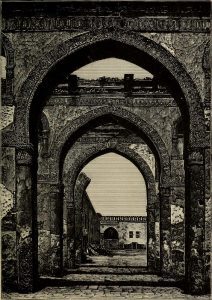
This series introduces the concept of living locations: places that possess a primitive sentience, personality, and awareness. These locations are not “alive” in the mtraditional sense but manipulate their environment and the creatures and objects within them.
Locations that fit this archetype in games, film, and literature include the house in the movie Monster House (2006), the apartment in 1408 (1999), and the town of Silent Hill in the game Silent Hill (1999). More examples might come to you if you think a bit.
A living location need not be a haunted house or a supernatural manifestation. It can include locations such as a workshop granted a semblance of life by clockwork magic or a mysterious tower of plants animated by the will of an elemental or fey lord.
Catch up on all the Living Locations articles! This article looks at how living locations can be put to use in a campaign.
Types of Living Locations
Living locations come in a variety of forms and functions. Some begin as regular castles, dungeons, or old manor houses before becoming infused with a measure of life (or unlife) by a magical or supernatural event. In contrast, others arise organically from the world or are created as living locations by malefic, natural, and divine agencies.
A selection of living locations is included under each of the headings below.
A Note about Intelligence and Alignment
Since living locations come in so many forms, it can be difficult to quantify their intelligence. Some living locations possess human-like or greater levels of intelligence and are can formulate plans and strategies. Others possess little more intelligence than your average golem or house cat.
Typically, the larger or older the living location, the more intelligent it might be. Its intelligence might also follow its function. For example, an archmage’s planar library might be more intelligent than a mere underground complex. Ultimately, the mental statistics of a living location are up to the GM.
Similarly, the alignment of a living location is determined mainly by the method of its creation. A townhouse possessed by a demonic essence would typically be chaotic evil in alignment, while a mill powered by clockwork magic would be unaligned or lawful. Exceptions exist, but consider how a living location’s came into existence to suggest an alignment.
Living Locations as Adventure Sites
A simple way to use a living location is as an adventure site. In this scenario, the living location plays a minimal role in the adventure’s purpose. A party of adventurers might explore a living location without realizing its true nature while experiencing effects of its manifestation. However, the GM has the option of surprising the players when the opportunity arises or making the adventure more challenging.
Some examples include:
- A group of divs (see Tome of Beasts 3) have holed up in an ancient tower and ambush passing caravans to satisfy their destructive urges. The building has become sentient thanks to exposure to long-forgotten elemental magic and views the divs as pets.
- Rumors say that the ruins of Rosewater Manor hold a gemstone of magnificent size and mysterious origin. The stone is said to bring untold riches to its possessor. Unluckily for the PCs (and unbeknownst to the locals), the manor became a living location during a terrible tragedy that killed its residents and transformed them into ravening spectral undead.
Living Locations as Plot Devices
An obvious use for a living location is as a plot device in which the location’s unusual nature is an important part of the adventure. In this context, reveal the true nature of the living location to the PCs prior to them entering it or reveal it at an appropriate time when the PCs are inside it.
Most of the time, the living location plays the part of yet another enemy or obstacle, but consider making it an ally or observer as a twist. The PCs might require the living location’s assistance to overcome a more powerful occupying threat. Of course, communicating with the living location to gain its assistance or prevent it from attacking is its own challenge!
Consider these scenarios where the living location is a plot device:
- A volcano has come to life both literally and figuratively thanks to ancient druidic magic gone awry. A venerable druid asks the PCs to resolve the situation. This requires them to enter the volcano’s heated tunnels and destroy the nest of elemental loci (see Tome of Beasts 1) that serve as its core.
- Seluvis Spire is a tower with the marble face of a bearded wizard carved into its outer walls. The tower uses magic mouth spells to communicate with anyone who approaches and is quite informative about the local area. The building is willing to serve as the base for aspiring adventurers if they undertake a series of quests on its behalf.
Living Locations as Villains
One of the more unusual uses for a living location is as the major villain of an adventure or campaign. Often living locations make poor villains because they don’t move or affect the world around them without possessing or controlling other creatures to do their bidding. Giving a location mobility is a worldbuilding challenge! Still, an evil, plotting location makes for an unexpected reveal.
Some examples include:
- An evil artifact is buried in a graveyard, granting the place a limited and malevolent sentience. The graveyard begins animating the dead interred within it and sending them out to gather more corpses to add to its mass. The PCs must stop the living graveyard before it depopulates the region.
- The combined malice of several prisoners condemned to death transforms a prison block into a living location that craves the death of anyone who enters it. The prison begins maliciously killing anyone who enters its corridors, innocent or otherwise.
